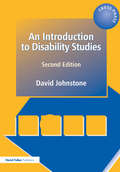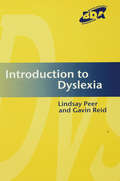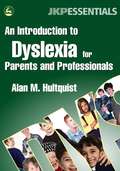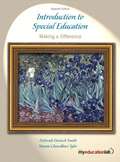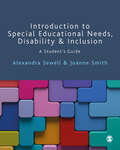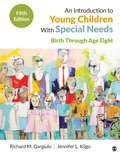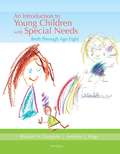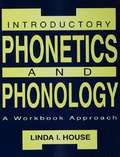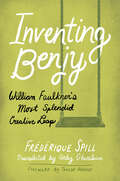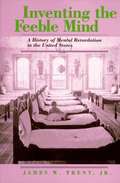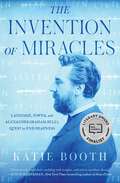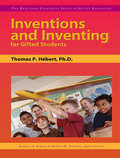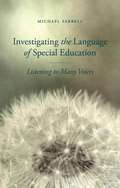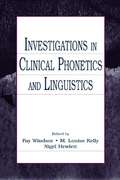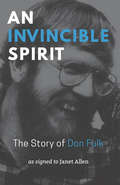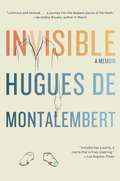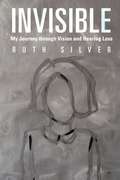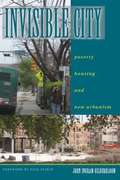- Table View
- List View
An Introduction to Disability Studies
by David JohnstoneDisability studies has become a legitimate area of academic study. It is multi-disciplinary in its critique of the oppressions that have historically "dumped" disabled people on the margins of society. This fully revised and updated edition not only explains disability studies as an academic field of inquiry, it also explores many of the current issues affecting the lives and circumstances of disabled people. The book explores and analyzes "quality of life" factors in the lives of disabled people in relation to the professional development of undergraduates and examines the emergence of "rights" for disabled people in the local area, the UK and abroad. The author indicates the strengths and weaknesses of organizations "of" and "for" disabled people, and provides examples of individual and institutional oppressions against disabled people and "success stories," exploring how these have been overcome in education and employment. The book suggests how disabled and non-disabled people can collaborate in the development of inclusive communities and neighborhoods. The text is suitable for students taking courses in the areas of health, social care and allied services at NVQ, BTEC, Degree and PGCE level. The author encourages students to raise their own questions and develop their own forms of inquiry.
Introduction to Dyslexia
by Gavin Reid Lindsay PeerThis work provides the class teacher with a straightforward introduction to dyslexia. The authors highlight methods of identification of dyslexia within the classroom context and provide examples of how dyslexia can be dealt with by the class teacher.
An Introduction to Dyslexia for Parents and Professionals
by Alan M. Hultquist'This book does exactly what it says on the tin! Hultquist deals with the causes, types and sub types of dyslexia. He explains how dyslexia is diagnosed and remediated and gives appendices on agencies, resources and practical classroom strategies. I would highly recommend this book to parents who have just received a dyslexia diagnosis in the family, to professionals working with those with dyslexia and to specialist teachers to have as a handy reference/refresher tool. For all these audiences, Hultquist writes in such measured, clear and uncluttered prose that no one can take the journey from diagnosis to remediation without feeling that one is in the hands of someone who really understands the issues surrounding a dyslexia diagnosis, not only for the one diagnosed but also for the whole family and the professionals working with them.' - Dyslexia Contact 'This short, to - the- point book is an absolute "must buy" for any parent with a child with dyslexia, or any teacher with a child with dyslexia in her class. I asked a parent of a child with dyslexia to read this book and give me an honest opinion. Her reply is as good a recommendation as any review I can write: "I could see my son straight away. I now understand why he has particular reading and writing difficulties. I hope his teacher reads this book and is able to take note of this author's advice.".' - Special Children Magazine 'This is only a short book, but it is a model of consciousness and clarity. It covers much ground and should fulfill its purpose as an introduction for both parents and teachers who wish to increase their understanding of dyslexia.' -The School Librarian Journal This practical guide provides basic need-to-know information for parents and professionals and answers frequently asked questions about dyslexia. Using illustrative case studies, Alan M. Hultquist addresses many of the issues surrounding dyslexia, including possible causes and subtypes, means of testing, remediation and the controversial matter of "staying back" to repeat a school year. He identifies possible methods of classroom accommodation for dyslexic students in a range of subject areas. The list of useful resources at the back of the book can be used by parents and professionals to help explain dyslexia to children, and to help them find further information and teaching tools. This complete introductory guide to dyslexia is a must-read for parents of children with dyslexia, especially parents with children who are newly diagnosed, and for all those who work with dyslexic children and their families.
Introduction to Locomotor and Multiple Disabilities - TNOU (Course 4 / 03 #SED-16)
by Tamil Nadu Open UniversityThe course aims to develop understanding about planning effective educational programme and functional activities for students with locomotor and multiple disabilities. This course intends to develop required skills in teacher trainee to identify the children with locomotor and multiple disabilities and also plan an effective programme education as well as for creating awareness on these conditions. Teacher is also expected to plan an effective therapeutic and programme and also refer for medical intervention whenever if necessary.
Introduction to Neuro Development Disabilities -TNOU (Course 4 / 02 #SED-15)
by Tamil Nadu Open UniversityThe course integrates relevant subject matter in the areas of Learning Disability, intellectual Disability and Autism Spectrum Disorder. This course will prepare preservice teachers to work with students with Neuro Developmental disabilities in inclusive and specialized settings. It fosters the acquisition of the broad-based knowledge and skills needed to provide effective educational programs for students with learning and behavior characteristics. The course emphasizes implications for educational and vocational programming, curriculum, and instruction.
Introduction to Sensory Disabilities - TNOU (Course 4 / 01 #SED-14)
by Tamil Nadu Open UniversityThis Course consists of Five Units dealing with Psycho-social and Family issues of Children with Hearing Impaired. Mainly the need and importance of psychosocial development of children with hearing impairment; the role of family, peers, and community in the psychosocial development of CWHI; family needs in parenting the children with hearing impairment; family empowerment and involvement in educational and community based rehabilitation programmes for children with hearing impairment. As a parent and as a teacher everyone should know about these details.
Introduction to Special Education: Making a Difference (7th edition)
by Deborah Deutsch Smith Naomi Chowdhuri TylerStudents and teachers have long relied on this comprehensive overview of the field of special education and the ways in which all teachers can help students with special needs to succeed in school and reach their full potential.
Introduction to Special Educational Needs, Disability and Inclusion: A Student′s Guide
by Alexandra Sewell Joanne SmithThis essential textbook equips you with a strong understanding of theories, policies and practices and how they impact on Special Educational Needs and Disabilities, guiding you through your SEND course or modules. It provides you with the foundations and tools necessary to think critically about the issues and developments concerning SEND, inclusion, and professional practice. The book includes: - Material surrounding mental health in childhood and adolescence - Chapters on global perspectives of SEND, and assistive technologies - Practical case studies, reflection questions and activities - Spotlights on key theories and research - Up-to-date information on policies impacting SEND
Introduction to Special Educational Needs, Disability and Inclusion: A Student′s Guide
by Alexandra Sewell Joanne SmithThis essential textbook equips you with a strong understanding of theories, policies and practices and how they impact on Special Educational Needs and Disabilities, guiding you through your SEND course or modules. It provides you with the foundations and tools necessary to think critically about the issues and developments concerning SEND, inclusion, and professional practice. The book includes: - Material surrounding mental health in childhood and adolescence - Chapters on global perspectives of SEND, and assistive technologies - Practical case studies, reflection questions and activities - Spotlights on key theories and research - Up-to-date information on policies impacting SEND
An Introduction to Working with the Aging Person Who Is Visually Handicapped (2nd edition)
by Dava GraysonThis book deals with aged blind persons, the ways and means of lending them a helping hand, services available to them, and solving other problems.
An Introduction to Young Children With Special Needs: Birth Through Age Eight (Education Ser.)
by Richard M. Gargiulo Dr Jennifer L. KilgoAn Introduction to Young Children with Special Needs: Birth Through Age Eight is a comprehensive introduction to educational policies, programs, practices, and services for future practitioners serving young children with delays or disabilities in early intervention-early childhood special education (EI-ECSE). Thoughtfully addressing the needs of children at risk for learning or development delays or disabilities, revered authors Richard M. Gargiulo and Jennifer L. Kilgo offer evidence-based interventions and instructional techniques that provide students with a broad understanding of important theoretical and philosophical foundations, including evidence-based decision making, developmentally appropriate practices, cultural responsiveness, and activity-based intervention.
An Introduction to Young Children With Special Needs: Birth Through Age Eight (Education Ser.)
by Richard M. Gargiulo Dr Jennifer L. KilgoAn Introduction to Young Children with Special Needs: Birth Through Age Eight is a comprehensive introduction to educational policies, programs, practices, and services for future practitioners serving young children with delays or disabilities in early intervention-early childhood special education (EI-ECSE). Thoughtfully addressing the needs of children at risk for learning or development delays or disabilities, revered authors Richard M. Gargiulo and Jennifer L. Kilgo offer evidence-based interventions and instructional techniques that provide students with a broad understanding of important theoretical and philosophical foundations, including evidence-based decision making, developmentally appropriate practices, cultural responsiveness, and activity-based intervention.
An Introduction to Young Children with Special Needs Birth Through Age Eight
by Jennifer L. Kilgo Richard M. GargiuloAN INTRODUCTION TO YOUNG CHILDREN WITH SPECIAL NEEDS offers a thorough introduction to the educational policies, programs, practices, and services specific to infants, toddlers, and preschoolers who demonstrate delays and disabilities. It also offers information about youngsters who exhibit signs of being at-risk for future programs in learning and development. Through a host of proven learning techniques, a website, and additional related resources, readers are guided to a full understanding of important theoretical and philosophical foundations in serving children whose learning is delayed. These include authentic assessments, cultural sensitivity and competence, activity-based interventions, and developmentally and individually appropriate practices. The book emphasizes instructional strategies necessary for creating inclusive learning environments, and offers recommendations throughout for using technology in the learning environment.
Introductory Phonetics and Phonology: A Workbook Approach
by Linda I. HouseSuccess in mastering any language requires knowledge in speaking, reading, and writing the language. The speaking component requires the understanding and use of correct pronunciation, emphasis, and syntactic patterns. The written component requires mastery of the alphabet, spelling, and the ability to write, print, or type the pattern. Very early in the learning process, speakers of the English language become keenly aware of the language's lack of sound to symbol correspondence. To help speech/language researchers, media personnel, individuals learning English as a second language, and others interested in correct pronunciation, the International Phonetic Alphabet (IPA) was devised. Extensively class tested, this book offers a practical understanding approach to phonetics and the IPA in a workbook format. It will be welcomed by professionals, students, and trainees in the fields of communication science, communication disorders, speech pathology, and linguistics.
Inventing Benjy: William Faulkner’s Most Splendid Creative Leap
by Frédérique SpillInventing Benjy: William Faulkner’s Most Splendid Creative Leap is a groundbreaking work at the intersection of Faulkner studies and disability studies. Originally published in 2009 by Presses de la Sorbonne Nouvelle as L’Idiotie dans l’œuvre de Faulkner, this translation brings the book to English-language readers for the first time. Author Frédérique Spill begins with a sustained look at the monologue of Benjy Compson, the initial first-person narrator in Faulkner’s The Sound and the Fury. Spill questions the reasons for this narrative choice, bringing readers to consider Benjy’s monologue, which is told by a narrator who is deaf and cognitively disabled, as an impossible discourse. This paradoxical discourse, which relies mostly on senses and sensory perception, sets the foundation of a sophisticated poetics of idiocy. Using this form of writing, Faulkner shaped perspective from a disabled character, revealing a certain depth to characters that were previously only portrayed on a shallow level. This style encompasses some of the most striking forms and figures of his leap into modern(ist) writing. In that respect, Inventing Benjy thoroughly examines Benjy’s discourse as an experimental workshop in which objects and words are exclusively modelled by the senses. This study regards Faulkner’s decision to place a disabled character at the center of perception as the inaugural and emblematic gesture of his writing. Closely examining excerpts from Faulkner’s novels and a few short stories, Spill emphasizes how the corporal, temporal, sensorial, and narrative figures of "idiocy" are reflected throughout Faulkner’s work. These writing choices underlie some of his most compelling inventions and certainly contribute to his unmistakable writing style. In the process, Faulkner’s writing takes on a phenomenological dimension, simultaneously dismantling and reinventing the intertwined dynamics of perception and language.
Inventing the Feeble Mind: A History of Mental Retardation in the United States
by James W. TrentJames W. Trent uses public documents, private letters, investigative reports, and rare photographs to explore our changing perceptions of mental retardation over the past 150 years. He contends that the economic vulnerability of mentally retarded people (and their families), more than the claims made for their intellectual or social limitations, has determined their institutional treatment.
The Invention of Miracles: Language, Power, and Alexander Graham Bell's Quest to End Deafness
by Katie BoothFinalist for the PEN/Jacqueline Bograd Weld Award for Biography Finalist for the Mark Lynton History Prize&“Meticulously researched, crackling with insights, and rich in novelistic detail&” (Steve Silberman), this&“provocative, sensitive, beautifully written biography&” (Sylvia Nasar) tells the true—and troubling—story of Alexander Graham Bell&’s quest to end deafness.&“Researched and written through the Deaf perspective, this marvelously engaging history will have us rethinking the invention of the telephone.&” —Jaipreet Virdi, PhD, author of Hearing Happiness: Deafness Cures in History We think of Alexander Graham Bell as the inventor of the telephone, but that&’s not how he saw his own career. As the son of a deaf woman and, later, husband to another, his goal in life from adolescence was to teach deaf students to speak. Even his tinkering sprang from his teaching work; the telephone had its origins as a speech reading machine.The Invention of Miracles takes a &“stirring&” (The New York Times Book Review), &“provocative&” (The Boston Globe), &“scrupulously researched&” (Pittsburgh Post-Gazette) new look at an American icon, revealing the astonishing true genesis of the telephone and its connection to another, far more disturbing legacy of Bell&’s: his efforts to suppress American Sign Language. Weaving together a dazzling tale of innovation with a moving love story, the book offers a heartbreaking account of how a champion can become an adversary and an enthralling depiction of the deaf community&’s fight to reclaim a once-forbidden language.Katie Booth has been researching this story for more than fifteen years, poring over Bell&’s papers, Library of Congress archives, and the records of deaf schools around America. But she&’s also lived with this story for her entire life. Witnessing the damaging impact of Bell&’s legacy on her family would set her on a path that overturned everything she thought she knew about language, power, deafness, and the telephone.
Inventions and Inventing for Gifted Students
by Thomas P. Hébert Kristen Stephens Frances KarnesInventing involves creativity applied to a problem-solving process, which can be taught. Through teaching instructional units on inventing, multiple creative skills are infused into one unit. Teachers who provide their students with such instruction see inventions as a natural way of packaging creativity training in an authentic and meaningful way. Applying creative thinking skills and a knowledge of a field of study to create exciting inventions is at the heart of the inventing process. This guide offers a practical introduction to the inventing process: getting students interesting in inventing, teaching the inventing process, patenting new product ideas, participating in inventions conventions and competitions, and an extensive listing of print and Web-based resources. This is one of the books in Prufrock Press' popular Practical Strategies Series in Gifted Education. This series offers a unique collection of tightly focused books that provide a concise, practical introduction to important topics concerning the education of gifted children. The guides offer a perfect beginner's introduction to key information about gifted and talented education.
Investigating the Language of Special Education
by Michael FarrellUtilising a wide range of theoretical traditions from philosophy, sociology and anthropology, this book aims to raise the reader's awareness of the power as well as the limitations of language in relation to special education.
Investigations in Clinical Phonetics and Linguistics
by Fay Windsor M. Louise Kelly Nigel HewlettInvestigations in Clinical Phonetics and Linguistics is a sequel to the eighth meeting of the International Clinical Phonetics and Linguistics Association, attended by delegates from 26 different countries. This book reflects the scope of the subject area of clinical phonetics and linguistics, the balance of input into it with respect to the different kinds of research being carried on, and the representation of researchers from different parts of the world. Its scope includes the application of all levels of linguistic analysis and the chapters of the book have been ordered as far as possible according to linguistic level, beginning with pragmatics and ending with acoustics. It will be immediately apparent that a greater number of chapters are concerned with applications of phonetics and phonology then with any other levels.
An Invincible Spirit: The Story of Don Fulk
by Janet Allen“Don taught us how to be a real independent living center. Nothing was easy; every issue that came up on the road to Don’s independence was a challenge and a struggle, but the experience pushed us and we learned from it. We were not going to let Don down; all of us were committed to Don’s freedom and independence.” —Kathleen Kleinman, Executive Director, TRPIL (Transitional Paths to Independent Living) Profoundly deafened as an infant, Don Fulk didn’t learn his name or go to school until the age of ten. When he was eighteen years old and a budding superstar on his football and basketball teams, he broke his neck in a swimming accident, and became paralyzed. After his injury, he was confined to a bed in his parents’ home for eight years, unable to move and barely able to communicate. After his family could no longer care for him, he spent nine years in a nursing home where he suffered from abuse and neglect. Yet through a life marred by isolation and frustration, Fulk endured with strength, humor, and grace. He never gave up pursuing his dreams for independence and self-worth, and improving the lives of others. He fought a system that was unfair and discriminatory, and helped pave the way for people with disabilities to live independently. Don Fulk signed his story to author Janet Allen, describing his difficult home life, the incredible friends who changed his life, and his dramatic escape from an abusive nursing home. An Invincible Spirit is a story of hope, empowerment, and the battles people with disabilities have fought—and continue to fight—to improve the quality of their lives.
An Invincible Spirit: The Story of Don Fulk
by Janet Allen“Don taught us how to be a real independent living center. Nothing was easy; every issue that came up on the road to Don’s independence was a challenge and a struggle, but the experience pushed us and we learned from it. We were not going to let Don down; all of us were committed to Don’s freedom and independence.” —Kathleen Kleinman, Executive Director, TRPIL (Transitional Paths to Independent Living) Profoundly deafened as an infant, Don Fulk didn’t learn his name or go to school until the age of ten. When he was eighteen years old and a budding superstar on his football and basketball teams, he broke his neck in a swimming accident, and became paralyzed. After his injury, he was confined to a bed in his parents’ home for eight years, unable to move and barely able to communicate. After his family could no longer care for him, he spent nine years in a nursing home where he suffered from abuse and neglect. Yet through a life marred by isolation and frustration, Fulk endured with strength, humor, and grace. He never gave up pursuing his dreams for independence and self-worth, and improving the lives of others. He fought a system that was unfair and discriminatory, and helped pave the way for people with disabilities to live independently. Don Fulk signed his story to author Janet Allen, describing his difficult home life, the incredible friends who changed his life, and his dramatic escape from an abusive nursing home. An Invincible Spirit is a story of hope, empowerment, and the battles people with disabilities have fought—and continue to fight—to improve the quality of their lives.
Invisible: A Memoir
by Hugues De MontalembertThe impressionistic memoir of an artist who was blinded in a sudden act of violence, leading to a profound meditation on what it means to see and be seen. "You live in a city like New York. You read the papers. You look at the television. But you never think it will happen to you. It happened to me one evening. " One summer night in 1978, Hugues de Montalembert returned home to his New York City apartment to find two men robbing him. In a violent struggle, one of the assailants threw paint thinner in Hugues' face. Within a few hours, he was completely blind. Eloquent and provocative, Invisible moves beyond the horrific events of that night to what happened to Hugues after he lost his sight: his rehabilitation, his solo travels around the world, and the remarkable way he learned to "see" even without the use of his eyes. Without a trace of self-pity, Hugues describes his transition from an up-and-coming painter to a blind man who had to learn to walk with a cane. His status changed in the eyes of other people as their reactions ranged from avoidance to making him their confidant. Hugues traveled to faraway places and learned to trust strangers and find himself at home in any situation. Part philosophy, part autobiography, part inspiration, Invisible will change the way readers understand reality and their place in the world.
Invisible: My Journey through Vision and Hearing Loss (2nd Edition)
by Ruth SilverRuth Silver's young life was challenged with vision and hearing loss. Inspired by her own experiences and challenges, she founded the Center for Deaf-Blind Persons in Milwaukee, a nonprofit agency dedicated to helping others living with the double disability of deaf-blindness. Ruth's story demonstrates how a resilient spirit can propel a profoundly disabled person forward toward a happy, productive life.
Invisible City
by John Ingram GilderbloomA legendary figure in the realms of public policy and academia, John Gilderbloom is one of the foremost urban-planning researchers of our time, producing groundbreaking studies on housing markets, design, location, regulation, financing, and community building. Now, in Invisible City, he turns his eye to fundamental questions regarding housing for the elderly, the disabled, and the poor. Why is it that some locales can offer affordable, accessible, and attractive housing, while the large majority of cities fail to do so? Invisible City calls for a brave new housing paradigm that makes the needs of marginalized populations visible to policy makers. Drawing on fascinating case studies in Houston, Louisville, and New Orleans, and analyzing census information as well as policy reports, Gilderbloom offers a comprehensive, engaging, and optimistic theory of how housing can be remade with a progressive vision. While many contemporary urban scholars have failed to capture the dynamics of what is happening in our cities, Gilderbloom presents a new vision of shelter as a force that shapes all residents.
